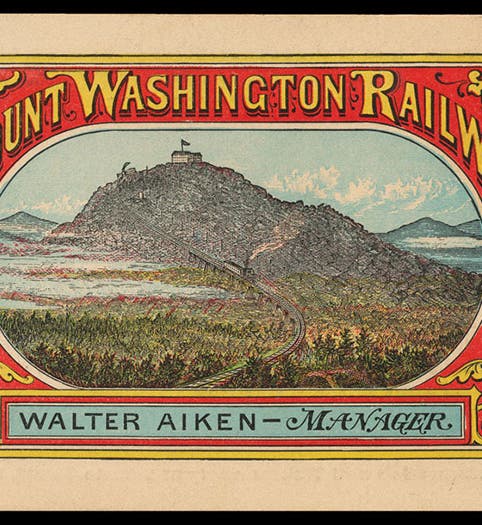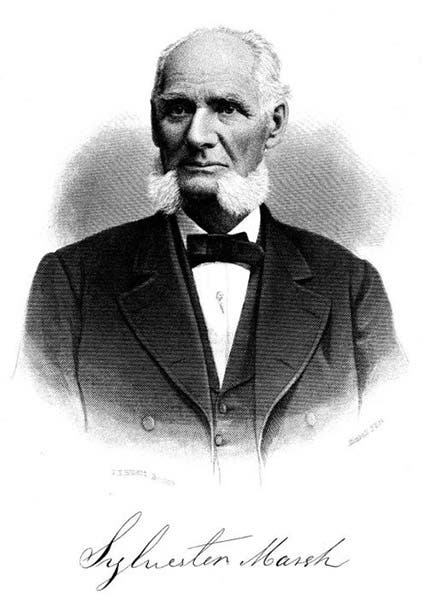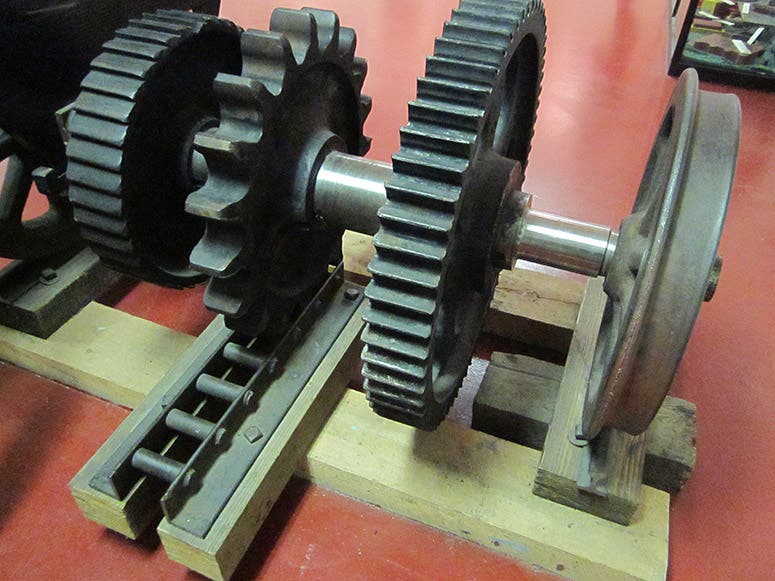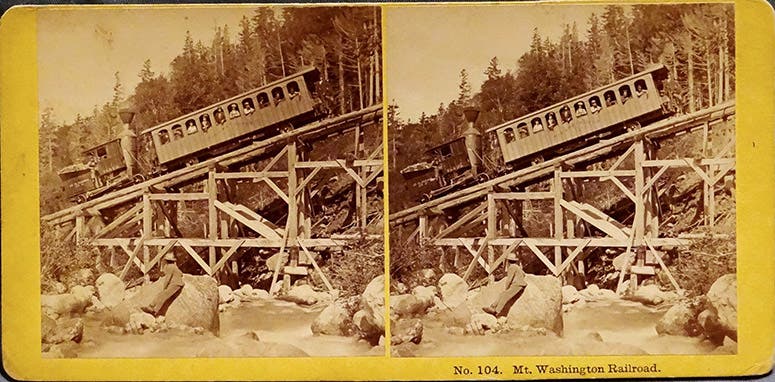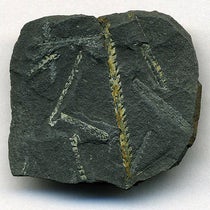Scientist of the Day - Sylvester Marsh
Sylvester Marsh, an American businessman, died Dec. 30, 1884, at the age of 81. Born in New Hampshire, Marsh lived many places and worked at a variety of trades in his life, as a meat packer, grain merchant, and exporter, along the way inventing quite a few devices to assist him in his various occupations. But he is best remembered for a singular achievement that grew out of a hike to the summit of Mount Washington in 1852. Mount Washington is in Marsh's native New Hampshire, in the White Mountain range, and is the tallest U.S. peak east of the Mississippi and north of Virginia, although it is only 6293 feet above sea level. But because it is higher than anything else for a thousand miles in any direction, it has ferocious weather, being the windiest place in the United States. You can check out the windspeed on the summit right now if you are interested; as I write this, the wind is blowing 62 mph, which is a mere breeze compared to the wind record there of 231 mph. Marsh almost died in a sudden storm that blew in on his 1852 hike, and spending an unexpected and unprotected night near the peak apparently set Marsh to thinking, in an inventorly kind of way. He decided it would be interesting to build a railway to the top of Mount Washington, where there was already a hotel. It would require a new kind of railway, since it was too steep for a traction locomotive, but that was the kind of challenge Marsh seemed to like.
Marsh managed to convince the New Hampshire state legislature to pass a bill in 1858, giving him exclusive rights to a Mount Washington railway, although he was subjected to considerable ridicule in the process, as no one thought it possible. His idea was to build a railway driven by a cog rail system, an idea he seems to have gotten from his future business partner, Walter Aiken. The Civil War threw a wrench into the plans, which was perhaps a good thing, as it allowed Marsh to work out the details of his cog railway. His idea was to have the pistons of a steam locomotive drive a toothed cog wheel on the bottom of the locomotive, which would engage a cog rail that ran down the center of the track. The cog rail consisted of two angle-irons with steel rods that ran between them every three inches or so; these were engaged by the cog wheel on the locomotive. You can see the cog rail in Marsh’s patent application of 1867 (third image, below), as well as in our fourth and fifth images.
In 1866, Marsh was ready to start building. He had his locomotive constructed in Massachusetts, by his engineer son, and freighted to the base of the mountain, which was the easy part. The hard part was laying the track, which was built entirely on a trestle framework. The railway, from the base at 2668 feet to the summit, would only be three and a half miles long, but the angle of ascent was prodigiously high, averaging 25 percent and reaching 37 percent on the final ascent. A great amount of lumber was required for the trestle; it was cut and milled locally, from a sawmill built just for the occasion. It required about a year per mile to construct. The railway was partially completed in 1868 and began to run with paying passengers; in 1869, it made it to the summit, and began regular runs on July 3, 1869. It was an immediate success, and has been running ever since.
The core of Marsh's railway was the cog rail system, which worked so well that is has been virtually unchanged in the 150 plus years since it opened, and has spawned similar railways around the world, especially in Switzerland. The engines were also ingenious, since they had to have boilers mounted on gimbals to enable then to function at a 25 percent grade. Marsh and Aiken later developed engines with rigid but slanted boilers that would only work on an incline. He also invented a compressed air system for braking on the way down, where the engine cylinders pumped air instead of being pumped by steam.
I rode the Mount Washington Cog Railway to the summit several times many years ago, and it was better than most amusement-park thrill rides, especially the final assault up Jacob’s Ladder, when passengers at the front end of the car are 20 feet higher in the air than those at the rear. I am not sure there was a museum there then, but there is now, where you may see a section of the original cog rail along with the gear drive from the locomotive (fifth image, above). The first locomotive is also on display at the base of the mountain (sixth image, below). Originally named “Hero,” it was soon nicknamed “Old Peppersass” after its resemblance to a bottle of pepper sauce. It is probably heavily restored, since it went off the rails and crashed down the mountain in 1929, one of the few accidents to mar the safety record of this otherwise impeccably-run railroad.
Three of our images today come from a webpage maintained by the Ephemera Society. I ordinarily do not use that many images from one site, but the page is so wonderful, with dozens of Cog-Railway-related trade cards, posters, stationery, and postcards, that I just couldn’t resist. And if you are partial to browsing eBay, you might search for “Kilburn Brothers Mount Washington Cog Railway.” The Kilburn Brothers were photographers, based in New Hampshire, and they began issuing stereocards or stereoviews in the 1860s. They were quite partial to the Cog Railway and published scores of stereocards beginning in 1868 showing engines and track running up Mount Washington. The one I include here (seventh image, below) I did not find on eBay, but on Flickr.
Sylvester Marsh is buried in Blossom Hill Cemetery in Concord, New Hampshire, in a family plot that also includes his parents, two siblings, two wives, and six children.
Dr. William B. Ashworth, Jr., Consultant for the History of Science, Linda Hall Library and Associate Professor emeritus, Department of History, University of Missouri-Kansas City. Comments or corrections are welcome; please direct to ashworthw@umkc.edu.

